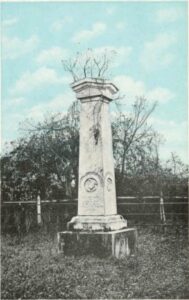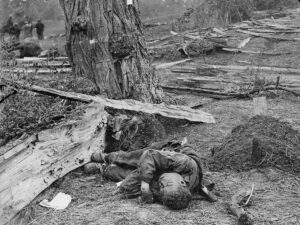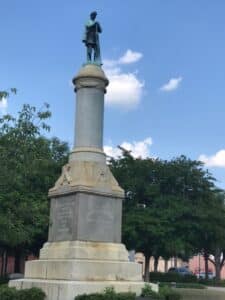On the North side of the Statehouse grounds in Columbia, SC, a Confederate soldiers monument was dedicated May 13, 1879. The inscription as pictured above, reads:
“This monument perpetuates the memory of those who, true to the instincts of their birth, faithful to the teachings of their fathers, constant in their love for the state, died in the performance of their duty . . . who have glorified a fallen cause by the simple manhood of their lives, the patient endurance of suffering, and the heroism of death . . . and who in the dark hours of imprisonment, in the hopelessness of the hospital, in the short sharp agony of the field, found support and consolation in the belief that at home they would not be forgotten.”
Editor
—–
What if there were 15.3 million dead American soldiers? Imagine it. Legions of the unburied down rows of summer corn, strewn along riverbanks, and discarded on roadsides. And imagine if many of the boys’ bodies had lain there for months or even years, for the fighting was so fierce and the resources so few that only the fortunate lay in shallow mass graves. Imagine, too, that in addition to the 15.3 million dead, many millions more young men were injured beyond any ability to resume their pre-war lives due to amputation, disease, and trauma.

First monument to the Confederate dead near Cheraw, South Carolina.
Were this to happen today, it would be the highest number of American casualties by many orders of magnitude. In comparison, American deaths during World War II were 405,000; because of their sacrifice we call them the “Greatest Generation.” What if casualties were thirty-eight times that? Stop for a moment to consider the ways in which so many deaths affect our national consciousness.
And, what if there were no so-called hallowed ground in which to bury these 15.3 million fallen heroes? What, as Americans, would we do? How would our nation grieve? We would grieve for generations. We would honor the fallen with remembrances in every city, town, and village. And we would honor the heroes that inspired the fallen.
This statistic, 15.3 million, is the number of lost soldiers there would be if present-day Americans were killed in the same proportion that Confederate soldiers were killed. There were 5.6 million citizens in the Confederacy, and four in five military-age men were summoned to duty, totaling 1.1 million men. About one in four, 260,000 of them, were killed. The statistic is sobering to even the most hard-drinking of generals.
With casualties of that proportion, is it any wonder that the South wanted to honor its dead with monuments in every square? The real outrage is not why monuments are still standing – it is why there are not more.

A dead Confederate soldier’s body ignored beside a Federal soldier’s grave.
Were it not for Ladies Memorial Associations, the predecessor of the United Daughters of the Confederacy, these men would have been little remembered. Ladies Memorial Associations undertook the grim duty of burying the sons, husbands, and brothers, whose bodies were still strewn across the landscape of the South at the end of the war.
Two sisters in Winchester, Virginia formed the first chapter after being horrified when local farmers plowing fields for planting unearthed human remains clad in butternut and gray. It is well documented that Union burial efforts – federally funded with an overflowing treasury – ignored Confederate dead. Without these groups of resolute Southern women, the only monuments would have been shattered Southern families and burnt farmhouses.
At Gettysburg, for instance, approximately 5,500 Confederates were killed. Soon thereafter, the Union planned a federal cemetery to honor only their own. Not so for Confederates – in a ghastly contrast, their bodies decomposed in forests and fields and shallow graves until they were brought home by Ladies Memorial Associations. Miraculously, a Virginia physician who lived in Gettysburg kept a journal with the details of Confederate mass graves which was used to locate them and bring them home one last time. Most, however, were not so lucky.

Memorial to the Confederate soldiers from Orangeburg, SC, who died fighting to defend their homes from Federal invasion and had no final resting place. The Orangeburg Council voted to remove the memory of those who gave the last full measure of their devotion to the Republic of South Carolina. The state legislature must vote on the act as the statue falls under the protection of the SC Heritage Act S.C. Code Ann. 10-1-165.
The process of disinterring and re-interring Southern boys was horrifying. Long-dead corpses were dug up and their pockets checked for identifying information, photographs, or letters. Their skulls and their bones were collected from the furrows of mass graves and assembled into imitations of men. They were sorted, carted for hundreds of miles on Southward-bound wagons, and, finally, sown in their native soil.
This process continued across the South for years after the war, grieving dirt-poor families donating their last pennies for the cold comfort of knowing their loved ones and neighbors were given a final resting place. It should come as no surprise, then, that the first Decoration Day was celebrated in the South.
It is because of the massive casualties and the difficulty in recovering beloved soldiers that Confederate monuments were built. If your son or brother were lost forever in a distant land, would you not gaze at a statute of a soldier in front of your courthouse, squint your eyes, and see him look dutifully back at you, even if just for a moment?
To argue that Confederate monuments are shrines to old prejudices is a gross misreading of history. Union monuments – many of which look almost identical to Confederate monuments – went up at exactly the same time and for the same reason: to commemorate beloved veterans. Notably, the vast majority of Union monuments speak about preserving the Union and treat slavery as an afterthought.

There are those whose hatred is so deep they have no respect for the dead. This is an example of a memorial to a Confederate soldier defaced.
Monuments were erected to honor Confederate men (and women) for their willingness to sacrifice their lives for their homeland. If 15.3 million American soldiers died today – no matter what cause – we would revere their sacrifice, we would pray for their immortal souls, and we would raise timeless memorials to their memory. If many of them had been lost in a foreign land, it would be that much more important to do so.
The tragedy of the war is either unknown or ignored by those who would tear down Confederate monuments. In the rush to remake the world in a new image, they forget that reform is meaningless unless we conserve that which gives meaning to today and tomorrow. The arc of history should be bent toward justice, not be snapped off. We should tremble to think how a generation 150 years from now would judge any one of us.
We need more heroes, not fewer. A people without the knowledge of its history, origin, and culture is like a tree without roots. The Greeks looked to their heroes for their bravery and wisdom, honoring their indelible impressions on the world. Psychoanalyst Carl Jung dove deep into the human unconscious and showed us that the hero archetype is innate – without heroes, we have only demons.

Grave markers to the dead destroyed by Black Lives Matter Marxists. This is similar to actions you see with ISIS.
The South needs its heroes, this generation of men who nobly served and often died for their homes. There is little example today of such dedication in support of any cause. Indeed, every generation, every creed and color, should erect monuments to its heroes. In a time of declining community cohesiveness and social dissolution, every community needs examples of the virtues it should endeavor to reflect.
In Bertolt Brecht’s play Galileo, one of Galileo’s students proclaims “Unhappy the land that breeds no heroes.” Galileo responds, “No, unhappy is the land that needs a hero.” Let us not be a land in need of heroes, but a land in which we stand on the shoulders of our heroes.
The South side of the Soldier’s monument inscription reads: “Let the stranger, who in future times reads this inscription, recognize that these were men whom power could not corrupt, whom death could not terrify, whom defeat could not dishonor, and let their virtues plead for just judgement of the cause in which they perished… Let the South Carolinian of another generation remember that the state taught them how to live and how to die, and that from her broken fortunes she has preserved for her children the priceless treasures of her memories, teaching all who may claim the same birthright that truth, courage and patriotism endure forever.” Editor
Duncan Killen is an attorney in North Carolina. This article first appeared in the Abbeville Blog.
SC State Legislature contact information.
Please “like”, comment, share with a friend, and donate to support The Standard on this page.




 RSS - Posts
RSS - Posts